

Polemic. A polemic /pəˈlɛmɪk/ is a contentious argument that is intended to establish the truth of a specific understanding and the falsity of the contrary position.
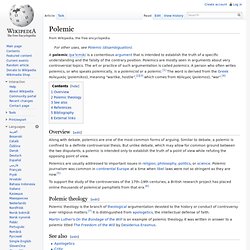
Polemics are mostly seen in arguments about very controversial topics. The art or practice of such argumentation is called polemics. A person who often writes polemics, or who speaks polemically, is a polemicist or a polemic.[1] The word is derived from the Greek πολεμικός (polemikos), meaning "warlike, hostile",[2][3] which comes from πόλεμος (polemos), "war".[4] Overview[edit] Along with debate, polemics are one of the most common forms of arguing. Polemics are usually addressed to important issues in religion, philosophy, politics, or science. Don't Overthink It: 5 Tips for Daily Decision-Making. In an interview last year, I asked acclaimed graphic designer James Victore what made him so efficient.

His simple reply: “I make decisions.” We make hundreds, if not millions, of micro-decisions every day – from what to focus our energy on, to how to respond to an email, to what to eat for lunch. You could easily argue that becoming a better (and swifter) decision-maker would be the fastest route to improving your daily productivity. After digging into the research, I learned that there are no hard and fast rules for decision-making. Nirvana fallacy. The nirvana fallacy is the informal fallacy of comparing actual things with unrealistic, idealized alternatives.
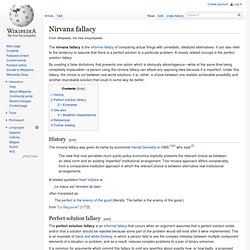
It can also refer to the tendency to assume that there is a perfect solution to a particular problem. A closely related concept is the perfect solution fallacy. By creating a false dichotomy that presents one option which is obviously advantageous—while at the same time being completely implausible—a person using the nirvana fallacy can attack any opposing idea because it is imperfect. Under this fallacy, the choice is not between real world solutions; it is, rather, a choice between one realistic achievable possibility and another improbable solution that could in some way be better. History[edit] The nirvana fallacy was given its name by economist Harold Demsetz in 1969,[1][2] who said:[3] The view that now pervades much public policy economics implicitly presents the relevant choice as between an ideal norm and an existing 'imperfect' institutional arrangement.
Perfect is the enemy of good. See also[edit] References[edit] Jump up ^ Georg Wilhelm Friedrich Hegel, Allen W.
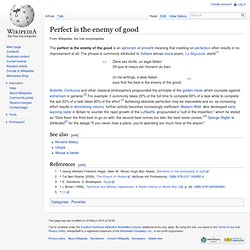
Categorial grammar. Basics[edit] A categorial grammar consists of two parts: a lexicon, which assigns a set of types (also called categories) to each basic symbol, and some type inference rules, which determine how the type of a string of symbols follows from the types of the constituent symbols.
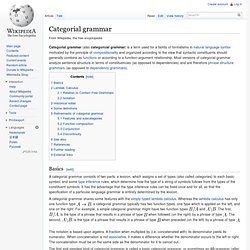
It has the advantage that the type inference rules can be fixed once and for all, so that the specification of a particular language grammar is entirely determined by the lexicon. A categorial grammar shares some features with the simply typed lambda calculus. Whereas the lambda calculus has only one function type. Poverty of the stimulus. Construction grammar. In linguistics, construction grammar groups a number of models of grammar that all subscribe to the idea that knowledge of a language is based on a collection of "form and function pairings".
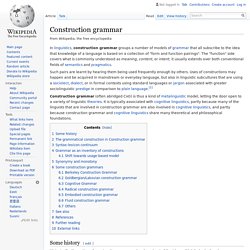
The "function" side covers what is commonly understood as meaning, content, or intent; it usually extends over both conventional fields of semantics and pragmatics. Construction grammar (often abridged CxG) is thus a kind of metalinguistic model, letting the door open to a variety of linguistic theories. It is typically associated with cognitive linguistics, partly because many of the linguists that are involved in construction grammar are also involved in cognitive linguistics, and partly because construction grammar and cognitive linguistics share many theoretical and philosophical foundations. Some history[edit] Sociology of scientific knowledge. The sociology of scientific knowledge (SSK) is the study of science as a social activity, especially dealing with "the social conditions and effects of science, and with the social structures and processes of scientific activity.

"[1] The sociology of scientific ignorance (SSI) is complementary to the sociology of scientific knowledge.[2][3] The sociology of knowledge, by contrast, focuses on the production of non-scientific ideas and social constructions. Sociologists of scientific knowledge study the development of a scientific field and attempt to identify points of contingency or interpretative flexibility where ambiguities are present. Such variations may be linked to a variety of political, historical, cultural or economic factors.
Crucially, the field does not set out to promote relativism or to attack the scientific project; the aim of the researcher is to explain why one interpretation rather than another succeeds due to external social and historical circumstances. Logical atomism. Logical atomism is a philosophical belief that originated in the early 20th century with the development of analytic philosophy.
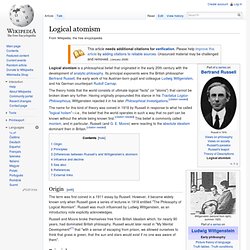
Its principal exponents were the British philosopher Bertrand Russell, the early work of his Austrian-born pupil and colleague Ludwig Wittgenstein, and his German counterpart Rudolf Carnap. The theory holds that the world consists of ultimate logical "facts" (or "atoms") that cannot be broken down any further. Having originally propounded this stance in his Tractatus Logico-Philosophicus, Wittgenstein rejected it in his later Philosophical Investigations. [citation needed] The name for this kind of theory was coined in 1918 by Russell in response to what he called "logical holism"—i.e., the belief that the world operates in such a way that no part can be known without the whole being known first. Origin[edit] The term was first coined in a 1911 essay by Russell.
Ordinary language philosophy. Ordinary language philosophy is a philosophical school that sees traditional philosophical problems as rooted in misunderstandings philosophers develop by distorting or forgetting what words actually mean in everyday use.

"Such ‘philosophical’ uses of language, on this view, create the very philosophical problems they are employed to solve. Bertrand Russell's views on philosophy. Philosophy of language. Analytic philosophy. Analytic philosophy (sometimes analytical philosophy) is a style of philosophy that came to dominate English-speaking countries in the 20th century.
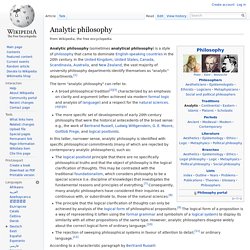
In the United Kingdom, United States, Canada, Scandinavia, Australia, and New Zealand, the vast majority of university philosophy departments identify themselves as "analytic" departments.[1] The term "analytic philosophy" can refer to: A broad philosophical tradition[2][3] characterized by an emphasis on clarity and argument (often achieved via modern formal logic and analysis of language) and a respect for the natural sciences.[4][5][6]The more specific set of developments of early 20th-century philosophy that were the historical antecedents of the broad sense: e.g., the work of Bertrand Russell, Ludwig Wittgenstein, G.
E. Moore, Gottlob Frege, and logical positivists. Theory of descriptions. The theory of descriptions is the philosopher Bertrand Russell's most significant contribution to the philosophy of language. It is also known as Russell's Theory of Descriptions (commonly abbreviated as RTD). In short, Russell argued that the syntactic form of descriptions (phrases that took the form of "The aardvark" and "An aardvark") is misleading, as it does not correlate their logical and/or semantic architecture. Universal grammar. Universal grammar (UG) is a theory in linguistics, usually credited to Noam Chomsky, proposing that the ability to learn grammar is hard-wired into the brain.[1] The theory suggests that linguistic ability manifests itself without being taught (see the poverty of the stimulus argument), and that there are properties that all natural human languages share.
Morpheme. Classification of morphemes[edit] Free vs. bound[edit] Every morpheme can be classified as either free or bound.[3] These categories are mutually exclusive, and as such, a given morpheme will belong to exactly one of them. Image schema. Figure 1 - Containment Image Schema In contemporary cognitive linguistics, an image schema is considered an embodied prelinguistic structure of experience that motivates conceptual metaphor mappings. Evidence for image schemata is drawn from a number of related disciplines, including work on cross-modal cognition in psychology, from spatial cognition in both linguistics and psychology,[2] cognitive linguistics,[3] and from neuroscience. [edit] Minimalist program. Cognitive linguistics. Inferential role semantics. Cognitive dissonance. In psychology, cognitive dissonance is the mental stress or discomfort experienced by an individual who holds two or more contradictory beliefs, ideas, or values at the same time, or is confronted by new information that conflicts with existing beliefs, ideas, or values.[1][2] Leon Festinger's theory of cognitive dissonance focuses on how humans strive for internal consistency.
When inconsistency (dissonance) is experienced, individuals tend to become psychologically uncomfortable and they are motivated to attempt to reduce this dissonance, as well as actively avoiding situations and information which are likely to increase it.[1] Language of thought. Knowledge representation and reasoning. Semantics. Montague grammar[edit] In the late 1960s, Richard Montague proposed a system for defining semantic entries in the lexicon in terms of the lambda calculus.
Lexical semantics. Context change potential. Proposition. Indexicality. Anaphora. Semiotics. Conceptual blending. Construals. Schema (Kant) Educational psychology. Language-game. Sociology of knowledge. Argumentation theory. Cognitive map. Argument map. Self-regulated learning. Metacognition. Linguistic competence. Transformational grammar.
Mental space. Idealized cognitive model. Frame semantics (linguistics) Formal semantics (linguistics) Denotation. Polysemy. Prototype theory. Underlying representation. Cognitive semantics. Merge (linguistics) Mental representation. Phoneme. Context-free grammar. Complement (linguistics) Deep structure. Government and binding theory. Trace (linguistics) Move α. Government (linguistics) Phrase structure rules. Participle. X-bar theory. Anaphora (linguistics) Government and binding theory. Principles and parameters. Null subject language. Second language acquisition. Tabula rasa. Center embedding. Language acquisition device. Concept map. Cognitive grammar. Force Dynamics. Conceptual metaphor. Head directionality parameter.
Relational grammar. Lexical functional grammar. Head-driven phrase structure grammar. Minimalist program. Generative grammar. Link grammar. Tree-adjoining grammar. Naïve realism. Type–token distinction. Cognitive metaphor. Train of thought. Russell's paradox. Bertrand Russell. Social interactionist theory.